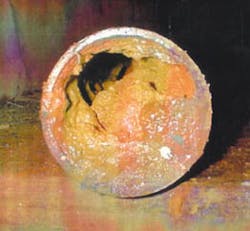I sat in on the Pump Guy Seminar this week in Philly, and an interesting discussion came up about the role control valves can play in proper pump operation.
One of the examples cited involved replacing a check valve with a backflow preventer in the discharge piping of a pump. This would increase the cumulative resistance in the system and drag the pump to the left of best efficiency on its performance curve. When the operator sees this, he or she could open the control valve on the discharge side of the pump, relax the resistance on the system, and allow the pump to slide back toward best efficiency.
Another example might be, if you’re pumping into a pressure vessel and suddenly the safety valve discharges on a downstream header, you’re going to lose all resistance in the system, slamming the pump’s duty point out to the far right of the best efficiency zone. In this situation, the pump is going to vibrate, the pump may overload the electric motor, and the pump may go into cavitation. The operator can save this pump from damage by restricting the control valve. Or, if the control valve is behind the header, you may need to pinch an isolation valve, which typically wouldn’t be recommended, but as the Pump Guy says, harkening back to his Navy days, “In a storm, any port will do."
RELATED: The Pump Guy’s Quick & Easy Tips for Resolving 85% of Cavitation Issues
RELATED: Do you know where the Pump Guy Seminar will be in 2014? Click here to find out.
Do You Know What’s Inside Your Pipe?When a pipe has been in service for a few months, it will begin to scale. As such, you can’t look at the pipe from the outside and predict the resistance on the inside. The pipe resistance will be different if the process is four months old or 30 years old.
When you have a large amount of resistance in the system due to buildup and/or scaling in the pipe, there comes a time when manipulating a control valve will no longer help. In this case, you would have two options: 1. install new pipe and fittings; or 2. buy a totally different pump. Clearly one of these options is the better solution for the long term …
Or maybe the process engineer needs more temperature in a downstream reactor vessel. The pump says, “Oh no, not again!”
More temperature in a downstream reactor means more backpressure on the pump that feeds the reactor. This will drag the pump back to the left on the performance curve, cause vibration, and reduce MTBF; unless somebody adjusts the system to bring the pump back into its best efficiency zone.
The solution would be to relax the control valve and allow the pump to slide toward best efficiency. When the reaction is complete and the temperature and pressure fall back to normal operating condition, the control valve would be throttled back to its previous position to ensure the pump doesn’t move out to the right on the curve.
“This is like driving a car,” says the Pump Guy. “But most operators aren’t trained in these techniques and therefore can’t effectively drive the pump.”
The Pump Guy acknowledges that a control valve in constant action like this will wear faster and require more frequent maintenance. But he says valve maintenance is much preferred to pump maintenance for the following reasons:
- No shims;
- No assembly alignment;
- No motor alignment;
- No coupling;
- No roller bearings;
- No lubrication;
- No mechanical seals;
- No high-speed rotation; and
- And little technical expertise required to change out a valve.
Further:
- There are no NPSH problems with valves;
- No internal recirculation;
- No off-design vibration problems;
- No shaft deflection;
- No dynamic balance issues to consider; and
- No strict tolerance parts and high-speed relative motion.
“Removing and exchanging a valve in the process line is infinitely easier than removing and exchanging a pump,” says the Pump Guy. “Work your valves, don’t stress the pumps!!!”
Matt Migliore is the director of content for Flow Control magazine and FlowControlNetwork.com. He can be reached at 610.828.1711 or [email protected].




